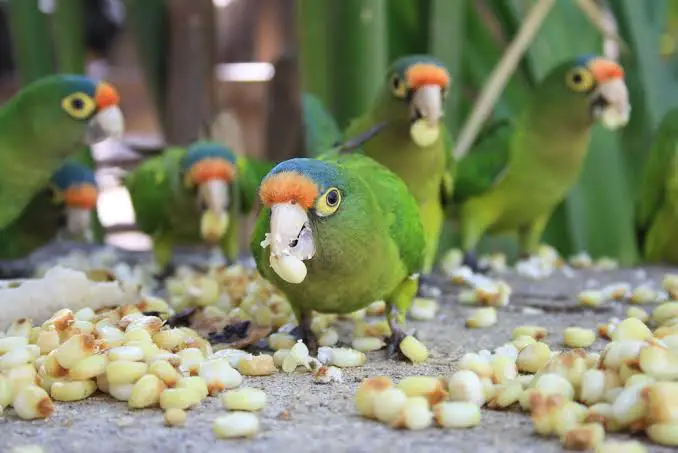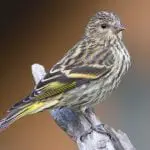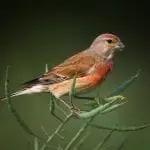Scientific Facts
| Common Name | Orange-Fronted Parakeet or half-moon conure |
| Scientific Name | Eupsittula Canicularis |
| Life Span | 20 to 30 years |
| Size | 11 to 12 inches |
| Habitat | Pacific Swamp, deciduous woodland, forest edge, savannah forest, cow pastures, thron scrub, and urban areas |
| Country of origin | Mexico to Costa Rica |
Physical Description
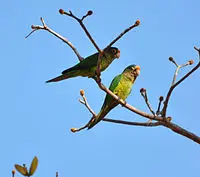
The orange-fronted conure is a small and green parakeet having its long tail. It features a bluish tint right through their plumage. The azure blue also can be seen on the primary coverts and the outer primaries. The lemon yellow is the crown’s color, and the frontal band right above the eyes is in orange color. The patches can be seen on any side of the rump. As for the males, the colors tend to be a lot brighter.
The pet bird measures 22.5 centimeters in length and 80 grams in weight. The adult orange-fronted conure is yellower and paler below and is also mainly green. This features an olive tone right through the breast.
As to its wings, they highlight yellow linings and blue outer primates. The tail is pointed while it is tipped in blue. The head is also somehow different, having an orange forehead, blue crown, bare yellow eye-ring, white bill, and yellow Iris. The young bird is also the same as the adult. It is just that there is just only a less orange in the forehead.
Colors and Markings
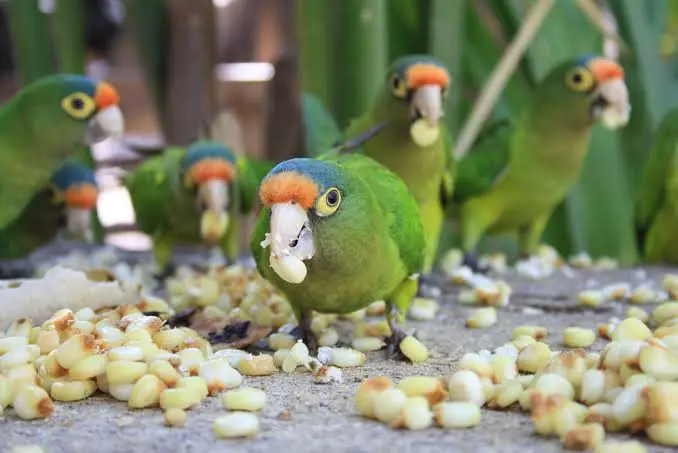
The orange-fronted conure is a lively-looking parrot that best displays an effective and simple color combination. This comes impressively with gradients of the plumage.
If you knew about the Peach-fronted conure, there is a similarity with the Orange-fronted conure. Its body is bright with a lighter and tropical green on the belly.
The cheeks are brownish-green in color. The upper head also displays some of the best and most unique details.
Look through the front part of the head in its orange patch. The blue patch is right behind it. The wings are blue and black in colors, specifically the flight feathers in there. The color has so far complemented the size of this bird. The charming and lovely touch and the colorful details complete the Orange-fronted conure.
History and Origin
This orange fronted-conure is a small and feisty conure that is loved around the world. This makes a popular pet like the parrot. This is known for its happy-go-lucky attitude and friendly personality.
And as far as its origin is concerned, it is by far the most numerous parrot to ever see on the Pacific Slope of Central America. This can be found as well in the western part of Mexico and south of Costa Rica. Its nest is usually seen in the self-excavated cavity in the arboreal termitarium.
Habitat
Commonly found in the foothills and the lowlands of the Pacific side of the central mountain ranges, the Orange-fronted Conure is just so great to have as a bird pet. This can be found in forest edges and canopies. This is also exposed more to the open woodland that includes the second growth and the savanna.
The Orange-fronted conure is termed as an arboreal termitarium breeder. This exhibits such a weird nesting behavior. It lays up its eggs in the termite mounds often found high up in the trees.
The popularity of the Orange-fronted Conure is just so common. But it no longer captured for the pet trade that decreases the population in some places. The situation becomes a lot better as the bird starts to have a healthy population in the wild forest.
Life Span
This orange-fronted conure is also famous for its other name of half-moon conure. This medium-sized parrot is available and popular. This can be your best bet for an Orange-fronted conure for its 16 years of life span.
Personality
Such a little and silly pet bird, the Orange-fronted conure, is a real creature to bring fun and excitement. This comes with a friendly and energetic personality. It is indeed charming, and it easily makes friends. It also enjoys being handled. It does need a sense of interaction with human beings.
The best thing about it is that it does not face issues as to sharing space with friendly parrots. It finds new ways to engage in playing activity. It also definitely loves playing with toys.
Its goofy and tricky behavior is never a surprise anymore. This means to say that you cannot neglect it. There is a lot of interaction at it during the day. This is an affectionate and loveable parrot that entertains friends. That is when you would love it more.
Temperament
What makes the Orange-fronted conure a popular pet bird breed is its happy-go-lucky attitude and friendly personality. Its agreeable and social characteristics make it a good choice among pet lovers. This has so far been considered fun-loving. This is also known for its playful and inquisitive personalities. This is even considered a good talker. This can somehow be very noisy. Nevertheless, this is not a good pet for those who have sensitivity to noise or those who are living in apartments.
Breeding and Reproduction
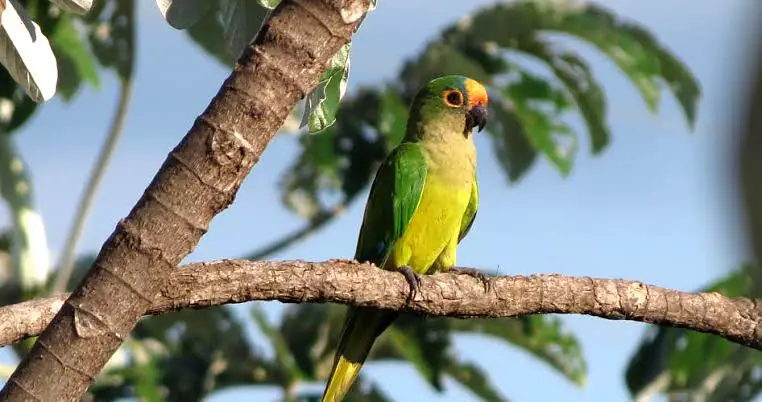
This Orange-fronted conure thrives in a natural environment. This is where it creates its nesting place in the termite mounds. It also digs out a long and upward climbing position. It also makes a sharp turn right through the cavity. It digs out in the middle of the mound.
This pet bird is so far observed to be using the natural hollow of the tree. This is when the termite mounds are nowhere to be found. This is somehow an exception and not a rule.
For captive breeding, this one is more difficult than any other conures. This is also due to their natural nesting place. The good thing about it is that it can be still successfully bred.
Although this bird will require to be surgically sexed or go through DNA for some sort of determination, the female still has a narrower frontal band.
The hen can lay 3 to 5 eggs, which also is one every other day. They are then incubated for about thirty days. As for the female orange-fronted conure, it broods the eggs. It does the part of initial feeding as the hatchlings are born first.
The male Orange-fronted conure takes over the feeding while the young fledge leaves the next after six weeks. The size of the next box to prepare for it must measure 12 inches by 10 inches by 10 inches. The entrance hole should fall at a diameter of 3.25 inches.
Where to Get One?
If you are interested in handling an Orange-fronted conure, get one from an online or local pet store. You could also easily get it from a professional breeder. They are those that specialize in the breeding and reproduction of Orange-fronted conures. No matter where you want to get the pet, make sure that it is an active and healthy bird. Check the bird before you finally purchase it.
How to Care for an Orange-fronted Conure?
The orange-fronted conure loves to take a bath in the water dish. It also loves to take a shower with a spray bath or with the presence of an owner. Also, give it a misting of warm water in the shower or the sink or with the use of a spray bottle.
The diet to be introduced should be nutritionally-balanced. There must be a manufactured diet supplemented with fruit and healthy foods and fresh vegetables.
This pet bird is not described as something destructive, like the many other conures. It could also be easily housed in a lightweight cage like the cockatiel cage. Better to include a roomy cage. This is also unless the bird will need to be left out for periods of play and exercise.
Diet and Feeding
When found in the wild, the orange-fronted conure eats nuts, figs, seeds, blossoms, and berries. This also has been greatly observed to feed on fruits. The feathers would be found to be something sticky.
In captivity, the Orange-fronted conure eats an avian form of pelleted diet. Its favorites are the bananas and the maize.
The pre-made commercialized seed mixture is also amazing. This is the best food choice for conures. This makes a perfect diet for your pet at home.
Add some more fresh fruits and vegetables. You will now give it a balanced diet. And you will now have a happy and fulfilled pet.
Hygiene is also essential in this regard. So, keep in mind the hygienic and bathing tips mentioned above. Make use of the spraying technique to make sure that the pet is groomed and clean.
Exercise
Offer the Orange-fronted conure an environment that is riched with so many opportunities for exercise and play. Better to add up some natural wood with differing textures and widths. This will help exercise the feet, and also the toenails, are kept short.
Common Health Problems of the Orange-fronted Conure
The Orange-fronted conure is the same as the conure birds to find around. They are hardy and healthy birds. They should be kept under such optimal conditions. And they need to be fed with a balanced diet.
Although they are known to be remarkably resistant to disease, there are still some signs of illness to be aware of. The goal is to maintain their conure health.
The signs of illness of an Orange-fronted conure include the ruffled plumage. They also can be seen as not eating or discharging from the mouth or the nostrils. They would often exhibit loose, watery droppings, cloudy eyes, weight loss, huge water intake, labored breathing, closing and opening of the mouth, and many more.
The common illnesses that the Orange-fronted conure contract are a respiratory infection, Candidiasis, Aspergillosis, sinus and cold inflammations, egg binding, diarrhea, eye infections, and egg picking. There also is a thyroid enlargement or goiter, feather plucking, frostbite, mites, psittacosis, Pacheco’s Disease, worms, and Salmonella.
Take an ailing Orange-fronted conure to the nearest avian veterinarian for proper diagnosis and treatment.
The behavior problems would often stem from missing in the environment of the bird. Lack of interaction, lack of trust, and boredom could lead to potential problems of biting, screaming, and feather plucking.
Spend more time with the bird and develop a bond of trust with it. This will help avoid any of those problems.
Housing
Just as this Orange-fronted conure loves being inside a roomy cage, why not introduce a cage for it that is best suited for it. It should be in a large size enough for the tail not to touch the bottom. The room should not limit the bird from moving.
A small-sized conure is perfect for a cage that measures 24-inches by 16-inches by 20-inches. The larger size of conure should have a cage of 44-inches by 26-inches by 40-inches. This will give room for both the vertical climbing and horizontal exercise.
Also, provide two of the perches. Place one of the perches up high for the roosting. One should fall below the water, food, and gravel dishes. The natural perches from poplar, willow, and fruit trees are perfect for the feet of the bird and the peak.
Place the cage exactly away from harmful drafts and fumes. Provide the pet with a sense of security. Cover the cage during the night.
Set up an indoor aviary in a room. The room of the bird will fall right in the interior of the aviary. The corn cob or the sand will cover the tiled floor. The breeding or outdoor aviary will need to be protected as a shelter. This can be cooled and heated when necessary. The size should be in a length of ten times the width, length, and height of 6-inches.
FAQs
Does the Orange-fronted Conure change night roosts during the night?
Yes, the Orange-fronted Conure changes its night roosts every night. But this does not mean that a popular and large roost will go untenanted during the evening. It will instead use the site for it to feel different on the successive nights.
What are these birds in the wild do during the sunny season?
The Orange-fronted conures would often be seen in pairs or partways during the dry season. This is when the nests already have fledged young. They often are in small-size of family groups of three to seven birds.
Is the Orange-fronted conure noisy?
The Orange-fronted conure is not noisy. It also is the same with other conures that can develop some respectable talking skills. This is so far considered the quietest of all the breed in species.
Does the Orange-fronted conure imitate sounds?
The Orange-fronted conure is known to the Southern and Central parts of America. It is known for its ability to imitate sounds to best address the individuals in a communication network.
What sets the Orange-fronted conure from the conures?
It is the highly-developed communication system of the orange-fronted conure that sets it different from the rest. This enables it to imitate the contact calls of individuals around.

